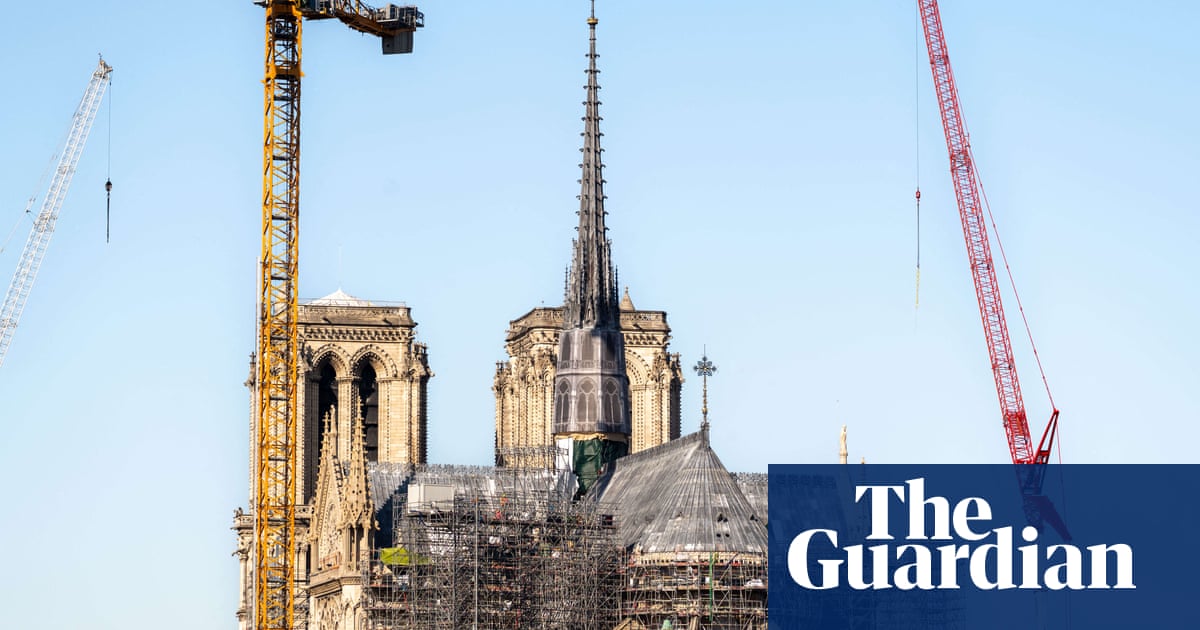Weeks before its scheduled grand reopening after a devastating fire, Notre Dame has become embroiled in an escalating row over whether to charge future visitors a fee to enter the 12th-century gothic masterpiece.
Franceâs culture minister, Rachida Dati, proposed this week that tourists visiting the Paris cathedral, known as âthe soul of Franceâ and one of the worldâs great architectural treasures, should pay a â¬5 entrance fee to help preserve the countryâs crumbling churches.
But while visitors to the most notable cathedrals in neighbouring countries, including Spain, Italy and Britain, routinely pay for the privilege, Franceâs Roman Catholic church is fiercely opposed to the idea, and experts have warned it could even be illegal.
Notre Dame is due to reopen on 8 December after narrowly escaping total destruction in April 2019 when flames tore through its wooden rafters and lead roof, toppling its monumental spire and prompting a mammoth five-year restoration project.
President Emmanuel Macron said at the time that the cathedral, visited by 12-14 million people a year before the fire, was âour history, our literature, our collective imagination â the place where we have lived all our great moments, our wars and our liberations. It is the epicentre of our life.â
But Dati told Le Figaro newspaper that, across Europe, people âhave to pay to visit remarkable religious edificesâ, adding that she had âsuggested a very simple idea to the archbishop of Paris: a symbolic fee for all tourist visits to Notre Dame.â
The scheme could raise up to â¬75m (£62m) a year, which would be âcompletely dedicated to a grand preservation plan for Franceâs religious heritageâ, she said. âNotre Dame would save all the churches of France. It would be a magnificent symbol.â
Franceâs interior minister, Bruno Retailleau, welcomed the idea, telling France Inter radio that if ââ¬5 can save Franceâs religious heritage, thatâs a good thing, whether one believes in heaven or not: quite simply, this is our landscape.â
Franceâs national heritage charity, the Fondation du Patrimoine, has described the state of many of the nationâs chapels, churches, abbeys and cathedrals as âvery worryingâ, with about 5,000 at risk and nearly 500 in such poor condition that they are closed to the public.
Guillaume Poitrinal, the bodyâs president, said it was âdelighted to see that politicians are finally beginning to understand the threat to our religious buildings: â¬75m a year could help prevent them from disappearing altogether.â
Many European cathedrals charge tourists. Tickets to Milanâs Duomo cost â¬10 to â¬30 (for a fast track pass and terrace access by lift, rather than the stairs), while St Markâs Basilica in Venice is a more modest â¬3 (plus â¬10 for the bell tower).
In Spain, the Mosque-Cathedral of Cordoba costs â¬13, Seville Cathedral charges â¬12 and the Sagrada FamÃlia in Barcelona â¬26. Canterbury Cathedral in the UK costs £17, Westminster Abbey £30 and St Paulâs £25.
For notable cathedrals in cities popular with tourists, the income can be substantial: the Sagrada FamÃlia, Antoni GaudÃâs masterpiece and the largest unfinished Catholic church in the world, raised more than â¬125m from its almost 5 million visitors in 2023.
Franceâs Catholic church, however, remains strongly attached to the principle of free access for all, whether worshipper or tourist, although some cathedrals do charge visitors to enter certain parts of the building, such as bell towers, crypts and treasuries.
Churches and cathedrals must be able to âwelcome all, unconditionally â thus necessarily free of charge â regardless of religion, belief, opinions and financial meansâ, the diocese of Notre Dame said in a stern statement.
after newsletter promotion
It added that given Notre Dameâs design, establishing a system that distinguished between tourists and people coming to the cathedral for private prayer would be âextremely complicated in terms of its practicalitiesâ.
It insisted it was open to âother schemes that do not consist of taxing visitors to the cathedralâ, but said a universal â¬5 entrance fee would âinevitably lead to people declining to visit a building that by its nature should be wide open to allâ.
The governmentâs suggestion could also run into legal difficulties under Franceâs 1905 secularism law, which separated the church and the state, transferring â among other things â the ownership of religious buildings from the former to the latter.
The law states that church visits âcannot be subject to any tax or dutyâ. Churches may charge visitors to enter certain rooms, for example, the bell tower, as Notre Dame itself did (for â¬17) before the fire, âbut you cannot charge for access to the building itselfâ, said Maëlle Comte, a public law lecturer at Jean Monnet University.
Since the 1905 law is not part of the French constitution, some legal experts have suggested the government, if it was really determined, could simply rewrite it. Either way, said Ariel Weil, the mayor of central Paris, something needs to be done.
âThe ministerâs proposal as it stands may not be possible,â Weil told Radio France, âbut it does raise the question of the huge number of visitors to Notre Dame and the colossal investments required in our religious heritage nationwide.â
It was by no means absurd, Weil said, to ask âwhether 12, 13, 14 million visitors a year could not do their bit. Perhaps a voluntary contribution, with a suggested fee at the entrance? Thereâs a price, but you donât have to pay it.â
Stéphane Bern, Macronâs heritage adviser, would go further. âNot when thereâs a service on,â he said. âItâs the house of God; it must be free then. But is it really so bad to charge tourists in shorts, with cameras round their necks?â

